Classic Undercutting How-To from TONIandGUY







After prepping the hair with a cutting lotion, a horseshoe section is started from the mid recession on each side. The horseshoe should sit just below the crown.



A diagonal back section is taken from the horseshoe down to just in front of the ear. Comb the section T to the part, elevate to 45°, and cut parallel to the diagonal back parting. Continue taking diagonal back sections, utilizing the same methodology and a traveling guide. Behind the ear, the diagonal back sections are taken through to the hairline at the nape.



Continue working in this manner until just past the center of the back.

Advertisement




Repeat the same approach on the opposite side, checking for balance as you go.



The weight line can be softened by elevating the hair in the comb, and breaking into the line with deep parallel point cutting.



A new horseshoe section, 1-inch in depth, is placed horizontally from high recession on both sides.



Starting in the back, comb 1-inch panels to natural fall, elevate to 45° and razor the lengths onto the underneath guide.

Advertisement




Work around the head shape to avoid overdirection. Behind the ear forward, a disconnection is created by continuing the line to the front hairline at this same length, disregarding the shorter guide underneath.



A profile section is taken at the natural part. The section is elevated to 90°, and utilizing a guide from the crown, layered through the front. Pivoting diagonal forward sections are over-directed to the profile guide, creating a soft inversion throughout the top. Repeat on the other side of the natural parting.



Sheers are used to dilute weight throughout the shape by combing vertical sections straight out and gently working the tool against the strand. (Key point: Start no closer than 2/3 the length of the section).





Classic Undercutting How-To from TONIandGUY
Zak Mascolo and the TONI&GUY Artistic Team use a classic undercutting technique to transform their model. The end result is full of volume, definition and unstoppable swing.
HOW-TO STEPS 
-

 1
1 -

 2
2After prepping the hair with a cutting lotion, a horseshoe section is started from the mid recession on each side. The horseshoe should sit just below the crown.
-
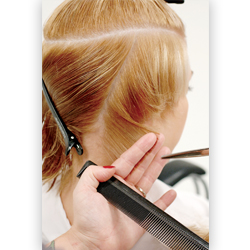
 3
3A diagonal back section is taken from the horseshoe down to just in front of the ear. Comb the section T to the part, elevate to 45°, and cut parallel to the diagonal back parting. Continue taking diagonal back sections, utilizing the same methodology and a traveling guide. Behind the ear, the diagonal back sections are taken through to the hairline at the nape.
-
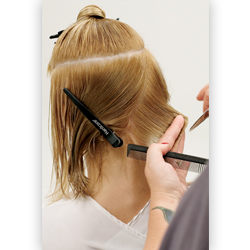
 4
4Continue working in this manner until just past the center of the back.
-
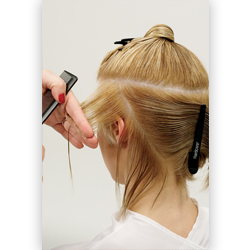
 5
5Repeat the same approach on the opposite side, checking for balance as you go.
-
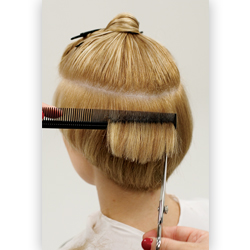
 6
6The weight line can be softened by elevating the hair in the comb, and breaking into the line with deep parallel point cutting.
-
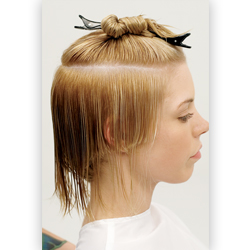
 7
7A new horseshoe section, 1-inch in depth, is placed horizontally from high recession on both sides.
-
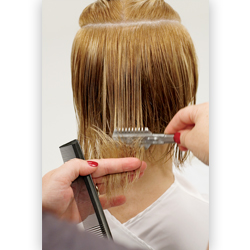
 8
8Starting in the back, comb 1-inch panels to natural fall, elevate to 45° and razor the lengths onto the underneath guide.
-
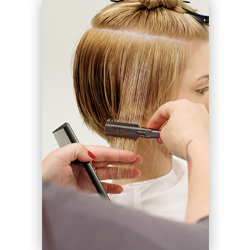
 9
9Work around the head shape to avoid overdirection. Behind the ear forward, a disconnection is created by continuing the line to the front hairline at this same length, disregarding the shorter guide underneath.
-
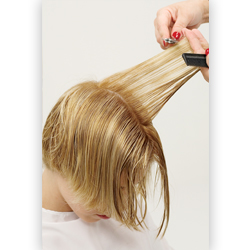
 10
10A profile section is taken at the natural part. The section is elevated to 90°, and utilizing a guide from the crown, layered through the front. Pivoting diagonal forward sections are over-directed to the profile guide, creating a soft inversion throughout the top. Repeat on the other side of the natural parting.
-
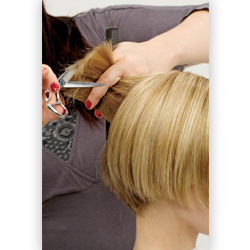
 11
11Sheers are used to dilute weight throughout the shape by combing vertical sections straight out and gently working the tool against the strand. (Key point: Start no closer than 2/3 the length of the section).
-

 12
12
YOU MIGHT LIKE THIS
-
Haircuts
Undercutting Technique from L’ANZA
-
Hair
Razored Undercut Crop from TONI&GUY
-
Barbering
The Hamilton from American Crew’s Independent Collection
-
Curls
How-To: Classic Styling Set
-
Nails
Classic Black + Gold Leaf Design


TRENDING NOW!
-
BTC Hair Trend Report
The Biggest Haircut Trends of 2024
-
Copper
What Is The "Cowboy Copper" Hair Trend? Here's What It Really Means...
-
Bobs
How to Avoid a Bulky Bob: 4 Techniques To Try
-
Hair Color
WWYD: How To Stop Your 6N From Turning Orange
-
Celebrity
10 BIPOC Celebrity Hairstylists Who Are Making Major Waves In The Industry Right Now
-
Uncategorized
TikTok's Viral "Scandinavian Hairline" Is Actually Not New...
-
Glossing/ Toning
How To Achieve "Glass Hair": Smart Hacks From Hairdressers
-
Curly
Long Layers: 10 Pro Tips + Common Cutting Mistakes




